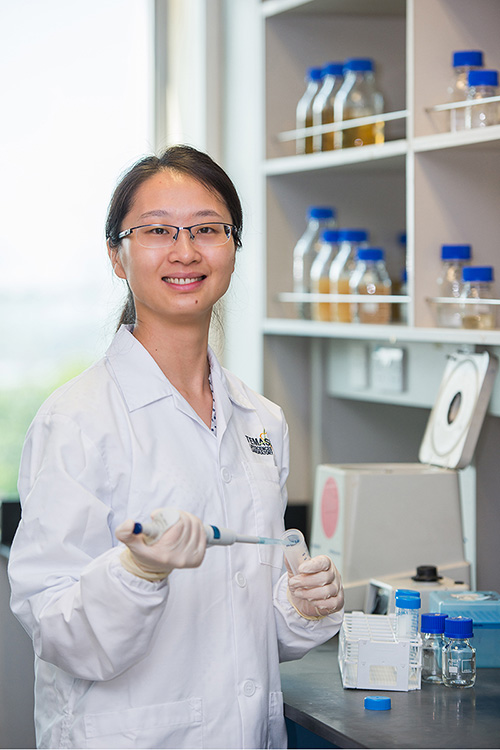
Impact
Membrane-bound organelles establish multiple membrane contact sites (MCSs) through which they communicate and coordinate their functions. By elucidating the nature and functions of endomembrane contacts, Zhang Dan’s lab aims to integrate their roles into a general framework of cell physiology, using the fission yeast Schizosaccharomyces pombe as the main model organism. We also translate and apply our basic findings to the studies of human fungal pathogens and yeast synthetic biology, aiming to develop strategies for both disease prevention and for generation of optimal yeast bioreactors.
Collaborations, Achievements & Honours
- Board Member, First Society for Cell Biology Singapore
- Discovered that Ca2+-dependent vesicular and non-vesicular lipid transfer controls hypoosmotic plasma membrane expansion.
- Discovered that VAP-mediated membrane tethering mechanisms and its function in pH homeostasis
- Discovered that coordinated cortical ER remodelling facilitates actomyosin ring assembly
- Discovered that plasma membrane furrows control plasticity of ER-PM contacts
- Discovered that ER-PM contacts restrict exocytic sites for polarized morphogenesis
- Discovered the interplay between endoplasmic reticulum membrane contacts and actomyosin cytoskeleton
- Recipient, Chinese Government Award for Outstanding Self-Financed Students Abroad, China Scholarship Council (2012)
Research Areas
Cell Biology, Fungal pathogen, Yeast synthetic biology
Affiliations
- Principal Investigator, TLL
- Adjunct Assistant Professor
- Department of Biological Sciences
- NUS
Question
How do membrane junctions form in the cells and what are their implications on organisms?
How is membrane contact function relevant to fungal pathogenicity?
Can we genetically engineer yeast cells by modifying membrane contacts to make optimal yeast bioreactors?
Approach
Zhang Dan’s lab studies the dynamics, formation and functions of intracellular membrane junctions. The lab is working to uncover the molecular basis and physiological consequences of the endoplasmic reticulum (ER) structure and dynamics, including the ER morphogenesis, its organelle contacts and cytoskeletal interactions by deploying multiple models and disciplinary approaches. These include model organisms of S. pombe, C. albicans, C. elegans, and yeast/worm genetics, biochemical tools, high-resolution live-cell imaging, microfluidics, omics, mathematical modelling and machine-learning techniques, to name a few.
Using yeast, Zhang Dan was able to discover a class of conserved proteins for membrane junction formation and regulation. She also revealed their important roles in maintaining cell polarity and regulating cell division. Interestingly, it was found that these proteins have been implicated in human motor neuron diseases. In particular, VAPs, the major players for membrane junction formation, are associated with amyotrophic lateral sclerosis type 8 (ALS8).
The endoplasmic reticulum (ER)-plasma membrane (PM) contact sites, thought to function in lipid trafficking and calcium signalling, are particularly prominent in yeast, plants and excitable cells in metazoans. A group of evolutionary conserved membrane integral proteins have also been identified to couple the ER and PM in various model systems. However, underlying mechanisms of the ER/PM contact formation remain poorly understood. Zhang Dan’s lab aims to uncover how these and potentially other proteins function in mechanistically tethering the ER to the PM.
The functions of ER/PM contacts in calcium and lipid homeostasis, as well as their potential involvement in the PM patterning and cell stress response, require further investigation. How the PM-vesicle crosstalk involves in the polarity and shape maintenance of fission yeast and other pathogenic fungi is also of interest.
Looking ahead, Zhang Dan hopes to initiate industrial projects for developing yeast-based synthetic biology tools, and expand the lab’s research focus into human fungal pathogen studies. Studying molecular cell biology of human pathogen provides essential insights into key components that define infections.
Bio
Zhang Dan received her Bachelor degree in bioengineering from Shanghai Jiao Tong University, China in 2006, and Doctor of Philosophy at the National University of Singapore (NUS) in 2013. Zhang Dan joined TLL as a Junior Research Fellow in 2007, where she completed her post-doctoral training and started an independent research group. She is currently Principal Investigator in TLL and adjunct assistant professor at NUS.
Principal Investigator
Zhang Dan
The lab studies dynamics, formation, functions and regulation of intra cellular membrane contacts.
Current Vacancies
-
Dr Zhang Dan Group: Assistant Research Officer
23 January 2025

